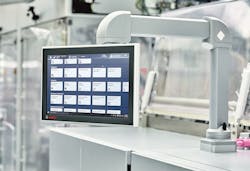Industrial automation applications, human machine interface (HMI) software and its related hardware are critical tools, hence the demand for HMI hardware is robust. According to a market report from Mordor Intelligence, the HMI market currently stands at $5.02 billion and is set to reach $7.34 billion by 2029, growing at a CAGR of 7.90%.
With so much demand for HMI technology, there is no shortage of available HMI hardware. This means that choosing the best device for your application requires serious examination of the options. To navigate these considerations, Automation World spoke with seven industry experts: Travis Quinn, product marketing manager-automation at ABB; Keegan Kim, project engineer at Actemium-Avanceon; Eric Reiner, industrial PC product manager at Beckhoff Automation; Alan Mathason, senior product manager for Emerson’s controls and software business; Michael Lohmeyer, general manager of hardware sales at Grantek; Al Letourneau, commercial portfolio manager, visualization and computing platforms at Rockwell Automation; and Ramey Miller, HMI product manager at Siemens.
Automation World: What are the primary types of HMI hardware available and what differentiates them?
Keegan Kim, Actemium-Avanceon: Typical HMI hardware includes panel and pedestal mount HMIs, desktop workstations and mobile devices. Panel mount HMIs typically come with vendor equipment skids and are preprogrammed with a SCADA application specific to that system. They include a touchscreen but can also include a tray-mount mouse and keyboard. Pedestal mount HMIs are standalone screens not tied to any existing panel or process equipment. They can be installed anywhere. Desktop workstations are traditional desktop computer setups with a thick/thin client, monitor, keyboard and mouse. Mobile devices, tablets or smartphones, are also usable as HMIs by remotely connecting them to a SCADA application and using their native multi-touch inputs.
Automation World: What factors should manufacturers consider when selecting HMI hardware for their specific industrial applications?
Travis Quinn, ABB: To ensure optimal performance and compatibility, manufacturers must assess the operations environment, considering temperature, humidity, exposure to dust, vibration and potential contact with chemicals and choose hardware with the appropriate environmental ratings. Functionality and features also play a significant role. Considerations include the type of user interface (touchscreen, physical buttons), display requirements (size, resolution) and communication interfaces compatible with existing industrial protocols (Modbus, Ethernet/IP). Manufacturers should also evaluate the HMI’s flexibility for customization, integration capabilities with PLCs and SCADA systems, and cybersecurity features.
Eric Reiner, Beckhoff: An HMI needs to deliver durability, dependability and high-performance in demanding environments. Users must be mindful of protection ratings as there are big differences in what to expect from hardware rated IP20, IP54 or IP65. In process industries and some discrete applications, it is common to encounter potentially hazardous environments. In these situations, you should seek explosion-proof display hardware rated for IEC Zone 2/22 and ATEX Class 1, Div 2.
Alan Mathason, Emerson: Manufacturers should consider their HMI needs holistically. Factors like application complexity, maturity of an organization to use available process information and how the manufacturer expects operators to interact with the machine will all weigh into these decisions. For example, if a machine requires dozens of buttons and knobs for set up and control, then physically installing these devices require an unacceptably large area. Integrating these functions into an HMI can reduce the panel size. It is important to consider that certain functions, especially safety or emergency stops, are best kept as physical buttons.
Al Letourneau, Rockwell Automation: Because automation projects come in all shapes and sizes, ideal solutions are those that offer a consistent programming environment and user experience across all platform types. Software-only vendors may have challenges when addressing applications that don’t require an open platform PC.
Modern HMI systems have the potential to go beyond interacting with personnel in proximity to plant operations. Given that expanded role, it’s essential to factor in the ability to access HMI devices securely from remote locations.
Also, be sure to work with a supplier that can offer local support and local stock. That will help manage both technical and schedule risks.
Ramey Miller, Siemens: When selecting HMI hardware, make sure to assess the number of devices that can be connected, number of tags or information that can be displayed, and what the operator experience should be to maximize system utilization. Additional factors include what happens with the information gathered by the HMI? Is it logged locally or does it need to go to a server? Are there remote access scenarios that need addressing? Ultimately, keeping the needs of the operator and the system’s functional output in mind makes the selection of the best HMI easier.
Automation World: How does HMI hardware impact operator training and user experience?
Travis Quinn, ABB: HMIs profoundly impact operator training and experience. HMIs provide intuitive controls and visual representations that simplify complex tasks, accelerating the learning curve for new operators. Touchscreens and user-friendly navigation facilitate quick response times and minimize errors. They enable operators to monitor processes in real-time, interpret data effectively and swiftly address issues.
Keegan Kim, Actemium-Avanceon: HMI location, available input methods, and screen size are key factors. Proximity of an HMI to the equipment it displays gives operators more context as to what is controlled by their actions and immediate feedback. For any process that requires operators to interface with both the HMI and equipment, HMIs should be located appropriately to minimize travel and input methods should be chosen based on actions operators must regularly perform.
Alan Mathason, Emerson: Using more capable HMI hardware improves the user experience, however, more complex hardware increases training needs. Manufacturers should also consider specifying HMIs with current capacitive multi-touch display technology. These displays provide higher brightness and allow operators to interact in ways they are familiar with from using consumer devices.
Al Letourneau, Rockwell Automation: HMI hardware and software can significantly flatten the learning curve. As veteran workers retire, new workers bring their experiences as consumers. They assume the HMI system supports the same gestures as tablets and smartphones, like pinch and swipe.
When an unexpected condition arises, providing operators with the instructions they need to start diagnosing the fault, and possibly correct it, can reduce or eliminate costly downtime. Work instructions and videos on the HMI screen can be a huge help.
Automation World: How does HMI hardware integrate with existing manufacturing systems and machinery?
Travis Quinn, ABB: HMIs connect to manufacturing systems via standard communication protocols like Modbus, Profibus, EtherNet/IP or OPC, facilitating data exchange with PLCs, SCADA systems and other industrial devices. These interfaces enable real-time data acquisition from sensors and control devices, providing operators with immediate insights into production metrics such as temperature, pressure and machine status.
Keegan Kim, Actemium-Avanceon: Many modern HMIs function as clients for remote hosted SCADA applications, meaning that new HMI hardware can be easily configured to access existing SCADA screens and gain full functionality. However, for existing systems that have HMIs with locally hosted applications, new HMI hardware must be configured to either function in parallel with existing HMIs or to fully replace them.
Both solutions require a detailed understanding of what functionalities existing HMIs possess and how multiple inputs from different HMIs should be handled before proceeding. From an installation perspective, mobile devices require no physical accommodations on the plant floor and can integrate with nearly any existing system where a wireless connection is available.
Eric Reiner, Beckhoff: Fortunately, this is one of the easier jobs. With standard connection technologies on HMI hardware, you can connect with any control device provided it offers common connections such as DVI and USB. Beyond physical connectors, OPC UA is frequently used on HMI hardware to connect what’s happening on the machine and plant floor to cloud-based systems.
Alan Mathason, Emerson: Modern machines use a range of fieldbus interfaces. Today, these are almost all Ethernet based, allowing the use of common cabling to support protocols like Profinet, Modbus TCP, OPC UA, MQTT, EtherNet/IP, EtherCAT, and others. Once the protocols are understood, it’s possible to use vendor-specific or user-developed software to design tools that either consume and/or interact with machine parameters, set points and other control tags.
As HMI capabilities increase, devices transition from a simple local screen to a network-connected device. Care should be taken to make sure networked HMIs do not become cybersecurity risks. The best way to manage this is to select interfaces that are secure by design, such as OPC UA.
Al Letourneau, Rockwell Automation: How HMI hardware integrates depends on the nature of the existing systems, but most modern HMI systems can connect to a heterogeneous landscape of control equipment from multiple sources using purpose-built protocol drivers for each network protocol. When both the HMI and control equipment come from the same provider there are opportunities for preferred compatibility. For example, some controllers allow you to configure your process alarms at the source and publish them to your HMI system without additional configuration. The result is the controller is the single source of truth and all alarms are referenced to a single set of alarm limits and timestamped from a common clock. At any given time, existing systems are subject to change, so select a provider that’s in it for the long haul and has demonstrated an enduring commitment to both innovation and support.
Automation World: What future trends do you foresee in HMI hardware for manufacturers?
Travis Quinn, ABB: Several trends will shape the future of HMI hardware. Artificial intelligence (AI) and machine learning will enhance HMIs with predictive analytics for maintenance and process optimization. Augmented reality (AR) and virtual reality (VR) integration will revolutionize training and maintenance tasks by providing immersive experiences and enhanced visualization. IoT connectivity will enable HMIs to collect and analyze data from interconnected devices, while cloud-based solutions will support remote access and real-time monitoring. Enhanced cybersecurity measures will safeguard HMIs from cyber threats and voice and gesture control technologies will enable hands-free operation.
Keegan Kim, Actemium-Avanceon: I foresee mobile devices becoming more widely adopted as HMIs in the near future. Mobile devices now provide comparable latency to wired HMIs while allowing for more flexibility in how they are used. For processes outside or that span large areas, a single mobile device can potentially replace the need for several stationary HMIs. As they are not fixed in harsh environments, they reduce the need for corrosion or process resistant HMI hardware. Similarly, traditional HMIs will likely continue to adopt multi-touch with gestures as their primary input source.
Eric Reiner, Beckhoff: What some see as a future trend, we're already doing with multi-touch, built-in cloud connectivity, plus automation and control via HMI hardware with integrated CPUs. I do see even larger display options becoming available and greater utilization of the HMI as a branding vehicle for OEMs and end users to boost the overall customer and employee experience.
Alan Mathason, Emerson: We see HMI products heading toward flexible architectures, allowing interaction to occur both on machine and with portable and wearable devices. Advanced HMI benefits will include faster response times, less waste and overall better operational efficiency. Though this has the potential to create a more meaningful and seamless link between the machine and the operator, it will raise the complexity of data security.
Michael Lohmeyer, Grantek: Wearable tech is a trend that holds a lot of promise. Augmented reality, which can be accessed via wearable tech, also gets a lot of attention by users. The value for training, maintenance, and operations is tremendous. I think we are seeing just the very beginning of how wearable technology will improve how people accomplish real tasks on a daily basis.
Al Letourneau, Rockwell Automation: You can expect to see increasingly comprehensive HMI hardware options that provide a more seamless continuum across the range of PCs, terminals and edge modules. In some cases, you’ll see overlap. For example, expect high-end sealed terminals that match the horsepower of certain PCs and industry-specific versions designed for different environments. That will allow selection of the best-in-class devices for the application.
Ramey Miller, Siemens: The interaction between the operator and the HMI is changing. Many things seen in the movies a decades ago are making their way to the industrial space. These include more flexibility with remote clients, integration of augmented reality to overlay the system information on the machine itself, touchless interaction, biometric login, and RFID badge authentication. Having the right HMI today can set a company up to handle new user scenarios in the future while minimizing the impact to implement them when the times comes.
Leaders relevant to this article:








